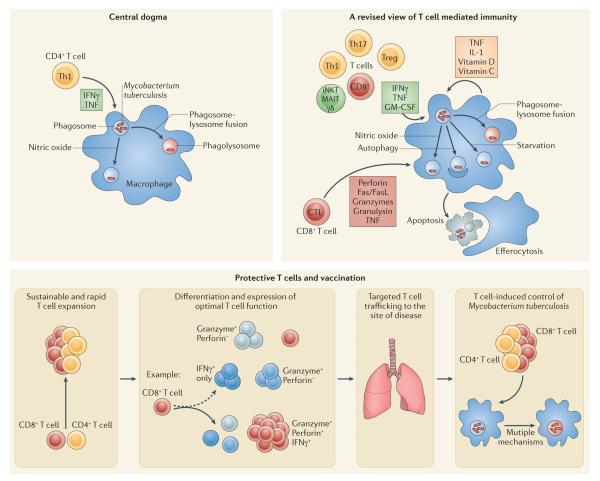Figure 2.
Paradigms of protective immunity to TB.
a. The “central dogma” of protective immunity to TB is that CD4+ T cells produce IFNγ, which synergizes with TNF (produced by the T cell or the macrophage), and together these activate macrophage antimicrobial activity capable of restricting M. tuberculosis growth. Two pathways activated by IFNγ that are capable of killing M. tuberculosis are nitric oxide (NO) production and phagolysosome fusion, which acidifies the bacterial phagosome.
b. “A revised view of protective T cell immunity” incorporates additional T cell subsets (CD4+, CD8+, and unconventional T cells – γδ T cells, MAIT cells and CD1-restricted T cells), and includes additional mechanisms by which T cells mediate killing of M. tuberculosis. These include additional cytokines (for example, possibly GM-CSF) and cytolysis of infected macrophages. The cytolytic mechanisms vary and can include cytotoxic granules, which can deliver antimicrobial peptides such as granulysin, but can also deliver granzymes, which can trigger apoptotic cell death. CTL activity mediated by FasL/Fas or TNF can also lead to apoptosis. Apoptosis can have a beneficial effect on the outcome of infection as infected apoptotic cells can be engulfed by bystander macrophages, which are capable of destroying the apoptotic cells including any intracellular bacteria. Finally, several components of the innate response, including IL-1 and vitamins, can synergize with cytokines produced by T cells.
c. “Protective T cells and vaccination” focuses on the desired features of protective T cell responses. Rationale vaccine design should aim to elicit protective T cells by optimizing their action on infected cells in several ways. Vaccine-elicited memory T cells must rapidly expand and generate secondary effector T cells that undergo sustained proliferation following activation. While the functions of primary effector T cells are expressed heterogeneously (broken arrow), vaccination (solid arrow) can lead to more homogenous expression of effector functions during the recall response. Such T cells, often identified as multifunctional T cells, may have a greater protective potential. Primed effector and memory T cells should efficiently traffic to sites of infection, but the kinetics of the response must be balanced with respect to T cell subsets, and limit the potential for T cell exhaustion, excessive inflammatory pathology, or an ineffective response that hinders T cell - target contact.

